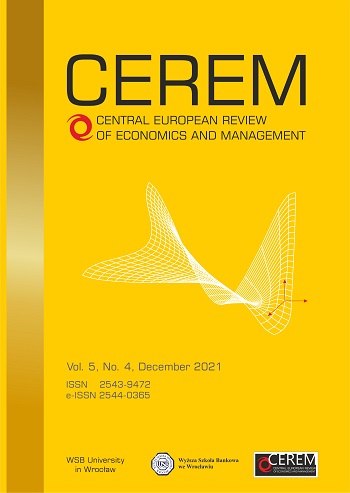A new digital currency system
DOI:
https://doi.org/10.29015/cerem.929Keywords:
monetary systems, payment systems, central banks, softwareAbstract
Aim: The aim of this paper is to describe the construction of a new system for digital currency governed by the central bank, Central Bank Digital Currency (CBDC). Although the system uses cryptography, it is a new alternative for crypto currency like the Bitcoin. Today there is a global discussion about the process of money creation by the commercial banks and the need for CBDC available for a broad public. There is almost no literature how such a system could be constructed. In this paper we fill this gap. The system we describe, uses modern cryptography that guarantees privacy on the one hand but that allows for traceability on the other hand. Also we consider the possibilities for new fintech initiatives and the new role of commercial banks.
Research methods: The research method can be classified as design research since we present a high-level model of the system as a proof-of concept. So it proofs that such a system is feasible in principle. It is expected that the paper contributes to the discussion on CBDC systems.
Conclusions: It is shown that it is indeed possible to design a CBDC system that is far more efficient than the well-known crypto currency systems. But the system uses one distributed system for transaction processing governed by the Central Bank or a trusted third party. This might be seen as a drawback but the system is performing only very elementary transactions that are easy to verify.
Originality: The approach is new. Although existing cryptography techniques are used, the system as such is a completely new alternative for CBDC.
Implications: The paper shows that a CBDC system is relatively easy to construct and so this paper could play a role in the transition to such a system in reality.
References
Admati A., Hellwig M. (2013), The Bankers New Clothes, Princeton University Press, New York.
BIS (2018), Central Bank Digital Currencies, https://www.bis.org/cpmi/publ/d174.pdf [01.09.2021].
Bordo M.D., Levin A.T. (2017), Central Bank Digital Currency and the Future of Monetary Policy, NBER Working Paper Series 23711.
Buiter W.H. (2009), Negative Nominal Interest Rates. Three Ways to Overcome the Zero Lower Bound, “The North American Journal of Economics and Finance”, vol. 20 no. 3, pp. 213–238.
Chaum D. (1983), Blind Signatures for Untraceable Payments, in: Advances in Cryptology, Chaum David, Rivest Ronald L., Sherman Alan T. (eds), Springer, Boston, MA, pp. 199–203.
Diffie W., Hellman M.E. (1976), New Directions in Cryptography, “IEEE Transactions on Information Theory”, vol. 22 no. 6, pp. 644–654.
ECB (2020), Report on a Digital Euro,
https://www.ecb.europa.eu/pub/pdf/other/Report_on_a_digital_euro~4d7268b458.en.pdf [01.09.2021].
Gilbert H., Handschuh H. (2003), Security Analysis of SHA-256 and Sisters, in: Selected Areas in Cryptography. SAC 2003. Lecture Notes in Computer Science, vol 3006, Matsui M., Zuccherato R.J. (eds.), Springer, Berlin, Heidelberg, pp. 175–193.
Ingham G., Coutts K., Konzelmann S. (2016), Introduction: ‘Cranks’ and ‘Brave Heretics’. Rethinking Money and Banking after the Great Financial Crisis, “Cambridge Journal of Economics”, vol. 40 no. 5, pp. 1247–1257.
Jackson A., Dyson B. (2012), Modernising Money. Why Our Monetary System Is Broken and How It Can Be Fixed, Positive Money, London.
Koblitz N. (1987), Elliptic Curve Cryptosystems, “Mathematics of Computation”, vol. 48 no. 177, pp. 203–209.
Kay J. (2009), Narrow Banking. The Reform of Banking Regulation, Centre for the Study of Financial Innovation, https://bankunderground.co.uk/wp-content/uploads/2016/07/c8439-narrowbanking2cthereformofbankingregulation2cbyjohnkay.pdf [01.09.2021].
Nakamoto Satoshi (2008), A Peer-to-Peer Electronic Cash System, https://bitcoin.org/bitcoin.pdf [01.09.2021].
Rivest R.L., Shamir A., Adleman L. (1978), A Method for Obtaining Digital Signatures and Public-Key Cryptosystems, “Communications of the ACM”, vol. 21 no. 2, pp. 120–126.
Roubini N., Mihm S. (2010), Crisis Economics. A Crash Course in the Future of Finance, Penguin Books, London.
Ryan-Collins J., Greenham T., Werner R., Jackson A. (2011), Where Does Money Come from, New Economics Foundation, London.
Sveriges Riksbank (2017), The Riksbank’s e-krona project: Report 1, https://www.riksbank.se/globalassets/media/rapporter/e-krona/2017/rapport_ekrona_uppdaterad_170920_eng.pdf [01.09.2021].
Taylor J.B. (1993), Discretion versus Policy Rules in Practice, “Carnegie-Rochester Conference Series on Public Policy”, vol. 39, pp. 195–214.
Wijngaard J., Van Hee K. (2021), Design of a rule-based monetary policy in a Central Bank Digital Currency system, “Central European Review of Economics and Management”, vol. 5 no. 4, pp. 61-95.
Downloads
Published
Issue
Section
License
The aim of CEREM is to make scientific work available in accordance with the principle of open access. The rules mentioned below are important, as they enable CEREM and its publisher, the WSB Merito University in Wroclaw, to distribute the scientific work to a wide public while complying with specific legal requirements, at the same time protecting the rights of the authors.
The author transfers to the WSB Merito University in Wroclaw, free of charge and without territorial limitations, with all proprietary copyrights to the said piece of work in the understanding of the act of 4th February 1994 on copyrights and derivative rights (Journal of Laws of 1994, no. 24, item 83, as amended) on an exclusivity basis, i.e. the rights to:
1. Make the piece of work in question available via the Digital Library established by the WSB Merito University in Wroclaw.
2. Produce, record and reproduce in multiple copies the piece of work using any techniques whatsoever, including printing, reprography, magnetic recording and digital processing, and particularly its reproduction by recording on CDs and similar data carriers,
3. Use fragments of the piece of work for promotional purposes in publications, promotional materials, the Internet and Intranet type networks managed by the WSB Merito University in Wroclaw.
4. Store the piece of work into computer databases managed by the WSB Merito University in Wroclaw.
5. Copy and reproduce the piece of work using photo-mechanic technologies other than those commonly known at the time of the signature hereof (photocopies, Xerox copies etc.),
6. Process the piece of work, transferring it into an electronic form, and distribute it on the Internet without limitations.


